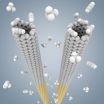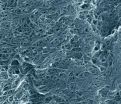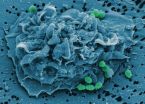(Press-News.org) Researchers from the University of Southern California (USC) and the National Institute of Standards and Technology (NIST) have demonstrated a technique for growing virtually pure samples of single-wall carbon nanotubes (SWCNTs) with identical structures, a process they liken to "cloning" the nanotubes.* If it can be suitably scaled up, their approach could solve an important materials problem in nanoelectronics: producing carbon nanotubes of a specific structure to order.
Single-wall carbon nanotubes are hollow cylinders of carbon atoms bound together in a hexagonal pattern, usually about a nanometer in diameter. One fascinating feature of nanotubes is that there are many ways to wrap the hexagon sheet into a cylinder, from perfectly even rows of hexagons that wrap around in a ring, to rows that wrap in spirals at various angles—"chiralities," to be technical. Even more interesting, chirality is critical to the electronic properties of carbon nanotubes. Some structures are electrical conductors—essentially a nanoscale wire—others are semiconductors.
"Experts in the electronics industry believe that single-wall carbon nanotubes are a promising option for nanoelectronics—semiconductor devices beyond today's CMOS technology," says NIST materials scientist Ming Zheng, "But for that particular application, the structure is critically important. A fundamental issue in that field is how to make single-wall nanotubes with a defined structure."
The problem is that methods for manufacturing carbon nanotubes, which often use a metal catalyst to initiate growth, usually produce a mixture of many different chiralities or twists—along with a lot of junk that's just soot. A lot of research has concentrated on schemes for "purifying" the batch to extract one particular kind of nanotube. And also you have to get rid of the catalyst.
The team led by Zheng and Professor Chongwu Zhou of USC took a different tack. NIST researchers had developed a technique for extracting nanotubes of a specific twist from a solution by using specially tailored DNA molecules that bind to one particular nanotube chirality.** The DNA trick is very selective, but unfortunately only works well with fairly short pieces of nanotube.
"That approach laid the foundation for this work," says Zheng. "We are using the short purified nanotubes to grow bigger structures of the same kind. We call it 'cloning', like cloning an organism from its DNA and a single cell, but in this case, we use a purified nanotube as a seed."
Small segments of nanotubes of identical chirality, extracted using the DNA technique, were put in a high-temperature reaction chamber at USC with methane gas, which breaks down in the heat to smaller carbon molecules that attach themselves to the ends of the nanotubes, gradually building them up—and preserving their structural chirality. "A bit like building a skyscraper," Zheng observes, though in these early experiments, the tubes are laying on a substrate.
"I think the most important thing this work shows is that from a chemistry point of view, it's entirely possible to grow nanotubes without a catalyst, and even maintain control of the structure," says Zheng, "It's a different approach, to do the separation first to obtain the 'seeds' and then do the synthesis to grow the desired nanotubes."
INFORMATION:
The research was funded in part by the Semiconductor Research Corporation's Focus Center Research Program, Functional Engineered Nano Architectonics, and the Office of Naval Research.
* J. Liu, C. Wang, X.Tu, B. Liu, L. Chen, M. Zheng and C. Zhou. Chirality-controlled synthesis of single-wall carbon nanotubes using vapor phase epitaxy. Nature Communications, 3, Article number: 1199. doi:10.1038/ncomms2205.
** See, for example, the Aug. 2, 2011, NIST news item, "Armchair Science: DNA Strands That Select Nanotubes Are First Step to a Practical 'Quantum Wire'" at www.nist.gov/public_affairs/tech-beat/tb20110802.cfm#dna.
'Cloning' could make structurally pure nanotubes for nanoelectronics
2012-11-15
ELSE PRESS RELEASES FROM THIS DATE:
NIST study suggests carbon nanotubes may protect DNA from oxidation
2012-11-15
Researchers at the National Institute of Standards and Technology (NIST) have provided evidence in the laboratory that single-wall carbon nanotubes (SWCNTs) may help protect DNA molecules from damage by oxidation. In nature, oxidation is a common chemical process in which a reactive chemical removes electrons from DNA and may increase the chance for mutations in cells. More studies are needed to see if the in vitro protective effect of nanotubes reported in the laboratory also occurs in vivo, that is, within a living organism.
"Our findings don't tell us whether carbon ...
Chronic fatigue syndrome -- a system under stress
2012-11-15
Australian researchers have discovered for the first time that reduced heart rate variability – or changes in heart beat timing – best predicts cognitive disturbances, such as concentration difficulties commonly reported by people with chronic fatigue syndrome (CFS). This adds to the growing body of evidence linking autonomic nervous system imbalance to symptoms of this poorly understood disorder.
The findings are reported in the journal PLOS ONE.
Chronic fatigue syndrome is characterised by medically unexplained, disabling fatigue and neuropsychiatric symptoms of ...
Flame retardants linked to neurodevelopmental delays in children
2012-11-15
Berkeley — Prenatal and childhood exposure to flame retardant compounds are linked to poorer attention, fine motor coordination and IQ in school-aged children, a finding by researchers at the University of California, Berkeley, that adds to growing health concerns over a chemical prevalent in U.S. households.
The new study, to be published in the Nov. 15 issue of the journal Environmental Health Perspectives, focuses on PBDEs, or polybrominated diphenyl ethers, a class of persistent, endocrine-disrupting compounds widely found in foam furniture, electronics, carpets, ...
At least one-third of marine species remain undescribed
2012-11-15
At least one-third of the species that inhabit the world's oceans may remain completely unknown to science. That's despite the fact that more species have been described in the last decade than in any previous one, according to a report published online on November 15 in the Cell Press publication Current Biology that details the first comprehensive register of marine species of the world—a massive collaborative undertaking by hundreds of experts around the globe.
The researchers estimate that the ocean may be home to as many as one million species in all—likely not more. ...
Surprising genetic link between kidney defects and neurodevelopmental disorders in kids
2012-11-15
New York, NY (November 15, 2012) — About 10 percent of kids born with kidney defects have large alterations in their genomes known to be linked with neurodevelopmental delay and mental illness, a new study by Columbia University Medical Center (CUMC) researchers has shown.
The study was published today in the online edition of the American Journal of Human Genetics.
Congenital defects of the kidney and urinary tract account for nearly 25 percent of all birth defects in the US and are present in about 1 in every 200 births. Eventually, an evaluation for genomic alterations ...
Appetite suppressant for scavenger cells
2012-11-15
This press release is available in German.
When infected with influenza, the body becomes an easy target for bacteria. The flu virus alters the host's immune system and compromises its capacity to effectively fight off bacterial infections. Now, a team of immunologists at the Helmholtz Centre for Infection Research (HZI) and cooperation partners has discovered that an immune system molecule called TLR7 is partly to blame. The molecule recognizes the viral genome – and then signals scavenger cells of the immune system to ingest fewer bacteria. The researchers published ...
This is your brain on freestyle rap
2012-11-15
Researchers in the voice, speech, and language branch of the National Institute on Deafness and Other Communication Disorders (NIDCD) at the National Institutes of Health (NIH) have used functional magnetic resonance imaging to study the brain activity of rappers when they are "freestyling" – spontaneously improvising lyrics in real time. The findings, published online in the November 15 issue of the journal Scientific Reports, reveal that this form of vocal improvisation is associated with a unique functional reallocation of brain activity in the prefrontal cortex and ...
About one million species inhabit the ocean
2012-11-15
Every taxonomist has calculated the number of existing species within their specialty and estimated the number that remain to be discovered, both through statistical models as based on the experience of each expert. According to Enrique Macpherson, researcher at the Center for Advanced Studies of Blanes (CEAB-CSIC, Spain), who has participated in the study: "Bringing together the leading taxonomists around the world to pool their information has been the great merit of this research".
The statistical prediction is based on the rate of description for new species in recent ...
Penn study decodes molecular mechanisms underlying stem cell reprogramming
2012-11-15
PHILADELPHIA – Fifty years ago, British researcher John Gurdon demonstrated that genetic material from non-reproductive, or somatic, cells could be reprogrammed into an embryonic state when transferred into an egg. In 2006, Kyoto University researcher Shinya Yamanaka expanded on those findings by expressing four proteins in mouse somatic cells to rewind their genetic clocks, converting them into embryonic-like stem cells called induced pluripotent stem cells, or iPS cells.
In early October, Gurdon and Yamanaka were awarded the 2012 Nobel Prize in Physiology or Medicine ...
Early 50s may be key time to reach baby boomers with health messages
2012-11-15
COLUMBUS, Ohio -- For baby boomers, the peak interest in health issues comes at about age 51, with a second peak coming near age 65, according to a new study.
The results may help doctors and other professionals target this generation with health messages at a time when they are most receptive to hearing them, the researchers said.
The study, based on a survey of Americans age 45 to 65, showed that people in their late 40s had the lowest levels of interest in health issues. Interest rose quickly, however, and peaked in the early 50s, then dropped slightly and plateaued ...




